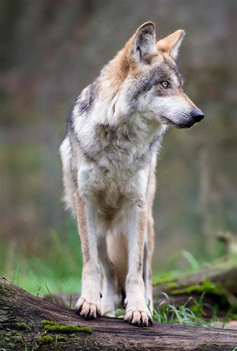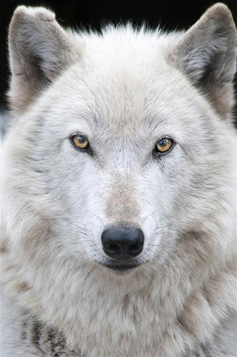Fun Wolf Facts
- Wolves have a very powerful sense of smell that is 100 times stronger than a human's.
- Critical to the food chain, wolves are apex predators (i.e. at the top of the chain) and help create balance in their ecosystems by mainly eating old, sick, or weak prey.
- Wolves have been known to "wolf" down their food and can eat up to 20 pounds of meat in one sitting.
- Howling is an important form of communication for wolves and can be used to find the pack, warn other packs to stay away, and to reinforce bonds with other pack members.
- While sleeping in the winter, wolves use their tails to help keep their faces warm.
Frequently Asked Questions about Wolves in Washington
Adapted from the Washington Department of Fish and Wildlife (WDFW) website, http://wdfw.wa.gov/conservation/gray_wolf/faq.html.
- Why are wolves important in Washington?
Wolves are native to Washington and part of the state's wildlife heritage. They were eliminated by the 1930's and are now returning to the state on their own. Restoring this endangered species will help return an important missing element of Washington's complex of carnivores. As a top predator, wolves naturally help keep wild elk, deer, and moose populations in balance with available habitat. - Won't wolves eat too many elk and deer?
This generally hasn't happened in other states. Deer and elk populations have remained stable, except in some areas where elk face other threats in addition to wolves. However, when wolves are present, elk may change their behavior and spend more time in the forest and at higher elevations where they are not seen by hunters—leading to a misperception that they have disappeared. - How do we keep wolves from eating livestock?
Some wolves in some areas have learned that livestock can be easy prey. Range riders, wolf-targeted fencing, night penning, guarding and herding animals, and removing carcasses can help reduce depredation but are not permanent solutions. - Were wolves re-introduced to Washington?
No. Wolves are returning naturally from populations in nearby states and provinces. - What land use restrictions come with wolves?
None. Wolves can adapt to living in many kinds of habitat, so land-use restrictions are not needed. Wolf dens, where pups are born, are protected by law from disturbance when occupied, just like songbird nests. - I think I saw a wolf, but how do I know for sure?
It was more likely a coyote. Wild wolves are few in number and usually stay away from people. Coyotes are abundant and somewhat bold. They are smaller than wolves (though this is hard to tell at a distance), with narrower snout, and tall, pointed ears. Large dogs and wolf-dog hybrids can also be mistaken for wolves, although they usually act more familiar with people. - I know I saw a wolf, so where do I report it?
WDFW and the U.S. Fish & Wildlife Service keep track of wolf sightings and other evidence (tracks, scat, howling, photos from motion-sensitive remote cameras). The best way to make a report is through the toll-free wolf reporting hotline, 1-888-584-9038. - Do wolves attack people?
Very rarely. Wild wolves generally fear and avoid people. In the past 60 years, there have been two wolf-caused human fatalities in North America (in Canada and Alaska). There have been no physical attacks on people by wolves in Idaho, Montana, or Wyoming from the time wolf recovery began in the 1980s until the present. - Do wolves attack dogs?
Yes. Wolves view dogs as competitors or territorial intruders and have attacked and killed them, especially in remote areas. Owners of dogs need to be aware of the potential risk to their dogs if they are in wolf habitat. - How many wolves are in Washington now?
Two wolf packs have been documented breeding in Washington since 2008—the Lookout Pack in Okanogan County and the Diamond pack in Pend Oreille County. A third pack, the Salmo pack uses habitat in Pend Oreille County and British Columbia. It is unknown yet where it dens. As of March 2011, only the Diamond Pack was considered a successful breeding pair—an adult male and female with at least two surviving pups. There may be another pack in the Blue Mountains and one in the North Cascades, but this remains unconfirmed. Small numbers of lone wolves also likely occur in the state. Overall, it was estimated there were likely 20—25 wolves in Washington at the end of 2010. - What is WDFW's "Wolf Conservation and Management Plan" and why is it being developed?
WDFW is developing a plan with strategies to achieve wolf population recovery, address and reduce conflicts with livestock, and maintain healthy deer and elk populations. The plan is needed because more wolves are naturally re-colonizing Washington from neighboring states and provinces. When wolves in Washington are removed from federal protection under the Endangered Species Act, the state of Washington will be responsible for managing them. The plan is also required under state endangered species law. A final EIS/recommended plan will be submitted to the Washington Fish and Wildlife Commission in August 2011. - How much will wolf management cost?
Preliminary cost estimates range from about $225,000 to $400,000 a year for monitoring, public outreach, research, and compensation for some anticipated future livestock losses. Costs are expected to be lower in the first few years of recovery, and increase as the state's wolf population grows in the future. The state shares costs with federal and private partners.



